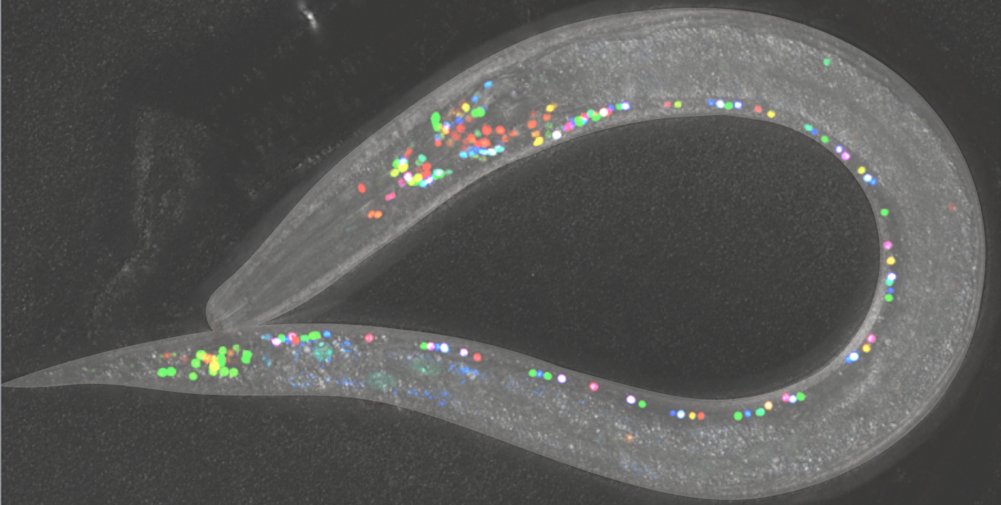In my research at the University of Vienna, I wanted to have a better understanding of behaviour. I wanted to understand how behaviour is organized and how it is produced. In order to do so, I studied the amazing nematode C. elegans.
C. elegans allowed me to analyze and quantify behaviour and behavioural transitions. In this video you can see a worm transitioning through different behaviours until it reaches de bacterial food patch (Dark round spot): Random (local) search, global search, directed chemotaxis and food exploitation.
I could record what the worms do at a very high resolution, like in this video of a worm laying twin eggs:
And I could also record the activity of their whole central nervous system at a single neuron resolution (!) while the worms were freely moving. See this video as an example:
By combining these two datasets: high resolution behavioural recordings and whole brain recordings we can understand better how brain activity drives behaviour, and how behaviour affects brain activity.
Some facts about C. elegans:
C. elegans has a fixed and determined number of neurons (300) and there is extensive knowledge on the function of almost each of them. This image shows the neurons of the NeuroPAL strain, each one labeled with a specific set of fluorophores:

Since the 80s we know the connectome, meaning the connections each of these neurons make, thanks to the pioneer work of John White, Sydney Brenner, and Eileen Shouthgate. And most recently, thanks to the amazing work of the Mei Zhen lab, we have a better idea of the variations of these connections across individuals (you can explore these datasets here):
Publications
An intrinsic neuronal manifold underlies brain-wide hierarchical organization of behavior in C. elegans - bioRxiv 2025
Charles Fieseler, Itamar Lev, Ulises Rey, Lukas Hille, Hannah Brenner, Manuel Zimmer.
A high affinity RIM-binding protein/Aplip1 interaction prevents the formation of ectopic axonal active zones - eLife 2015
Matthias Siebert, Mathias Böhme, Jan Driller, Husam Babikir, Malou Mampell, Ulises Rey, Niraja Ramesh, Tanja Matkovic, Nicole Holton, Suneel Reddy-Alla, Fabian Göttfert, Dirk Kamin, Christine Quentin, Susan Klinedinst, Till F. M. Andlauer, Stefan W. Hell, Catherine A. Collins, Markus C. Wahl, Bernhard Loll, Stephan J. Sigrist.
Presynaptic Spinophilin tunes Neurexin signaling to control active zone architecture and function - Nature Communications 2015
Karzan Muhammad, Suneel Reddy, Jan Driller, Dietmar Schreiner, Ulises Rey, Mathias Böhme, Christina Hollmann, Niraja Ramesh, Harald Depner, Janine Lützkendorf, Tanja Matkovic, Dominique Bergeron, Jan Schmoranzer, Fabian Goettfert, Matthew Holt, Markus Wahl, Stefan Hell, Peter Scheiffele, Alexander Walter, Bernhard Loll, Stephan J. Sigrist.
Suneel Reddy-Alla, Mathias Böhme, Eric Reynolds, Christina Beis, Andreas Grasskamp, Malou Mampell, Marta Maglione, Meida Jusyte, Ulises Rey, Husam Babikir, Anthony McCarthy, Christine Quentin, Tanja Matkovic, Dominique Bergeron, Zeeshan Mushtaq, Fabian Göttfert, David Owald, Thorsten Mielke, Stefan W. Hell, Stephan Sigrist and Alexander Walter.
Presynaptic biogenesis by axonal transport of lysosome-related vesicles - Neuron 2018
Anela Vukoja, Ulises Rey, Astrid Petzoldt*, Dennis Vollweiter, Christoph Ott, Christine Quentin, Dymtro Puchkov, Eric Reynolds, Martin Lehmann, Svea Hohensee, Stefanie Rosa, Reinhard Lipowsky, Stephan J. Sigrist and Volker Haucke.
Rapid active zone remodeling consolidates presynaptic potentiation - Nature Neuroscience 2019
Mathias A. Böhme, Anthony W. McCarthy, Andreas T. Grasskamp, Christine B. Beuschel, Pragya Goel, Meida Jusyte, Desiree Laber, Sheng Huang, Ulises Rey, Astrid G. Petzoldt, Martin Lehmann, Fabian Göttfert, Pejmun Haghighi, Stefan W. Hell, David Owald, Dion Dickman, Stephan J. Sigrist & Alexander M. Walter
PhD thesis
The results of my work at the Sigrist lab are compiled in my PhD thesis, which you can read here.
